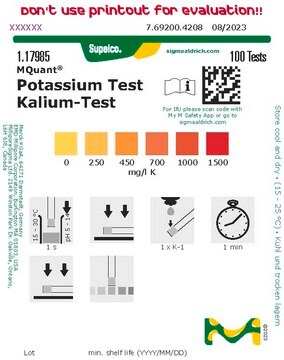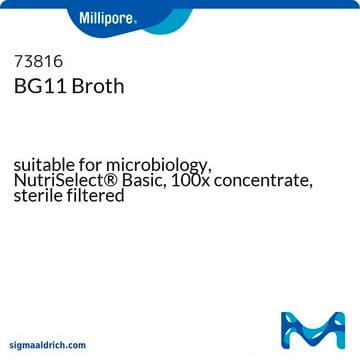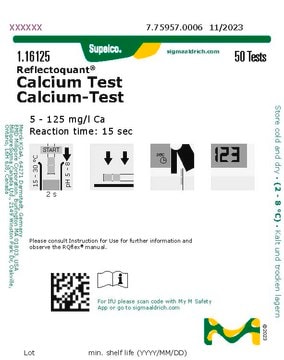Products may be shipped at a different temperature than the recommended long-term storage temperature. If the product quality is sensitive to short-term exposure to conditions other than the recommended long-term storage, it will be shipped on wet or dry-ice. If the product quality is NOT affected by short-term exposure to conditions other than the recommended long-term storage, it will be shipped at ambient temperature. As shipping routes are configured for minimum transit times, shipping at ambient temperature helps control shipping costs for our customers. For more information, please refer to the Storage and Transport Conditions document: https://www.sigmaaldrich.com/deepweb/assets/sigmaaldrich/marketing/global/documents/316/622/storage-transport-conditions-mk.pdf
MAK022
Calcium Colorimetric Assay
sufficient for 250 colorimetric tests
About This Item
Produits recommandés
Utilisation
sufficient for 250 colorimetric tests
Application(s)
cosmetics
food and beverages
Méthode de détection
colorimetric
Maladie(s) pertinente(s)
neurological disorders; hematological disorder
Température de stockage
2-8°C
Description générale
Application
Caractéristiques et avantages
Adéquation
Principe
Remplacé(e)(s) par
Mention d'avertissement
Danger
Mentions de danger
Conseils de prudence
Classification des risques
Aquatic Chronic 3 - Eye Dam. 1 - Skin Irrit. 2
Code de la classe de stockage
12 - Non Combustible Liquids
Point d'éclair (°F)
Not applicable
Point d'éclair (°C)
Not applicable
Faites votre choix parmi les versions les plus récentes :
Certificats d'analyse (COA)
Vous ne trouvez pas la bonne version ?
Si vous avez besoin d'une version particulière, vous pouvez rechercher un certificat spécifique par le numéro de lot.
Déjà en possession de ce produit ?
Retrouvez la documentation relative aux produits que vous avez récemment achetés dans la Bibliothèque de documents.
Les clients ont également consulté
-
How is shipping temperature determined? And how is it related to the product storage temperature?
1 answer-
Helpful?
-
-
How can I determine the shelf life / expiration / retest date of this product?
1 answer-
If this product has an expiration or retest date, it will be shown on the Certificate of Analysis (COA, CofA). If there is no retest or expiration date listed on the product's COA, we do not have suitable stability data to determine a shelf life. For these products, the only date on the COA will be the release date; a retest, expiration, or use-by-date will not be displayed.
For all products, we recommend handling per defined conditions as printed in our product literature and website product descriptions. We recommend that products should be routinely inspected by customers to ensure they perform as expected.
For products without retest or expiration dates, our standard warranty of 1 year from the date of shipment is applicable.
For more information, please refer to the Product Dating Information document: https://www.sigmaaldrich.com/deepweb/assets/sigmaaldrich/marketing/global/documents/449/386/product-dating-information-mk.pdfHelpful?
-
-
Could you provide the Kd (binding affinity) for calcium and clarify if the kit measures all calcium or just free/unbound calcium?
1 answer-
The kit uses the chromogenic complex (λ = 575 nm) formed between calcium ions and 0-cresolphthalein, specifically measuring free calcium and not the bound calcium. However, there is no available information regarding the Kd (binding affinity).
Helpful?
-
-
For the analysis of the standard curve, is it supposed to result in a linear curve or plotted as a polynomial?
1 answer-
The standard curve for product MAK022 should be fitted using linear regression. The x-axis will be the 0 (assay blank), 0.4, 0.8, 1.2, 1.6, and 2.0 μg/well standards with the OD 575 nm on the y-axis for each of the respective standards after the standard blank subtraction.
Helpful?
-
-
Hello, just wanted to confirm if this assay detects the free Ca2+ only and not the bound Calcium, correct?
1 answer-
Yes, this kit measures only free calcium and not bound calcium. The kit utilizes the chromogenic complex formed between calcium ions and 0-cresolphthalein.
Helpful?
-
Active Filters
Notre équipe de scientifiques dispose d'une expérience dans tous les secteurs de la recherche, notamment en sciences de la vie, science des matériaux, synthèse chimique, chromatographie, analyse et dans de nombreux autres domaines..
Contacter notre Service technique






